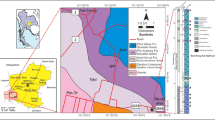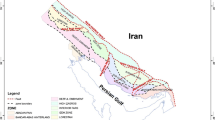Abstract
The Campanian-Maastrichtian Dakhla Formation consists mainly of dark gray, laminated shale with siltstone and sandstone inter-beds containing highly organic matter and is a potential source rock. The main objectives of the present research are to correlate the geochemical characteristics of the Dakhla Formation east and west of the River Nile in Upper Egypt and to discuss the main reasons for their variations. Fifty-nine samples were collected from the Komombo Basin and examined along with 230 published ditch and core samples from Gebel Duwi. These data indicate that the quality of the Dakhla source rock potentially varies from fair to good in the Komombo Basin with TOC 0.46–2.66 wt.% and good to excellent in Gebel Duwi with TOC of 2.1–14 wt.%. Additionally, the Dakhla Formation kerogen is type III and type I/II kerogen in the Komombo Basin and Gebel Duwi, respectively; the organic matter of the Dakhla Formation in the Komombo Basin is mostly of terrigenous origin, while in Gebel Duwi, it is mostly of marine origin. Based on vitrinite reflectance (%Ro) and Tmax values, the analyzed samples of Dakhla source rock are in the immature to early mature stage for oil and gas generation in both areas where the Tmax values have a range of 422–444 °C in the Komombo Basin and 412–435 °C in the Gebel Duwi area, while %Ro values range from 0.43 to 0.78% in the Komombo Basin.













Similar content being viewed by others
References
Abdelhady A, Darwish M, El Araby A, Hassouba A (2016) Evaluation of Neocomian shale source rock in Komombo Basin, Upper Egypt. Int J Innov Sci Eng Technol 3:376–382
Abu El Ella N (2006) Biostratigraphy and lithostratigraphy of Komombo-1, Komombo-2, Komombo-3, Nuqra-1 and Kharit-1 Wells, Upper Egypt. Earth Resources Exploration (EREX internal report
Abu El Ella N (2011) Biostratigraphic studies for the AlBaraka oil field, Upper Egypt. Earth Resources Exploration (EREX) internal report
Ali M (2017) Tectonostratigraphy and petroleum system analysis of Al Baraka Oil Field, Komombo Basin, South Western Desert, Egypt (Master thesis 1-186)
Ali M, Darwish M, Abdelhady A, Essa MA (2017a) Structural and lithostratigraphic evolution of Al Baraka Oil field, Komombo Basin, Upper Egypt as deduce from 2D seismic lines and well logging data. J Basic Environ Sci 2:149–169. 1
Ali M, Darwish M, Abdelhady A, Essa MA (2017b) Case study of seismic interpretation in in Al Baraka Oil Field, Komombo Basin, Upper Egypt, the fifth international conference for young scientist in basic and applied science
Ali M, Darwish M, Essa MA, Abdelhady A (2018) 2D seismic interpretation and characterization of the Hauterivian–Early Barremian source rock in Al Baraka Oil Field, Komombo Basin, Upper Egypt. J Afr Earth Sci 139:113–119
Ali M, Abdelhady A, Abdelmaksoud A, Darwish M, Essa MA (2019) 3D static modeling and petrographic aspects of the Albian/Cenomanian Reservoir, Komombo Basin, Upper Egypt. Nat Resour Res 28:1–23
Awad GH, Ghobrial MG (1965) Zonal stratigraphy of the Kharga Oasis. Geol Survey Egypt, paper 34, 77 pp
Barthel KW, Herrmann-Degen W (1981) Late Cretaceous and Early Tertiary stratigraphy in the Great Sand Sea and its SE margins (Farafra and Dakhla Oases), SW Desert, Egypt. Mitt Bayer Strrtssl, Palaont Hist Geol 21:141–182
Bosworth W, El-Hawat AS, Helgeson DA, Burke K (2008) Cyrenaican “shock absorber” and associated inversion strain shadow in the collision zone of northeast Africa. Geology 36:695–698
Cornford C (1984) Source rocks and hydrocarbons of the North Sea. In: Glennie KW (ed) Introduction to the Petroleum Geology of the North Sea. Blackwell Scientific Publications, Hoboken, pp 171–204
Demaison GJ, Moore GT (1980) Anoxic environments and oil source bed genesis, vol 64. AAPG Bull, pp 1179–1209
Demaison GJ, Hoick AJJ, Jones RW, Moore GT (1983) Predictive source bed stratigraphy: a guide to regional petroleum occurrence: Proceedings of the 11th World Petroleum Congress. London 2(p):17–29
Dow WG (1977) Kerogen studies and geological interpretations. J Geochem Explor 7:79–99
El-Kammar AM (2015) Source-rock evaluation of the Dakhla Formation black shale in Gebel Duwi, Quseir area, Egypt. J Afr Earth Sci 104:19–26
El-Kammar AM, Morsy RS, Sharabi S (2013) Biostratigraphical, petrographical and mineralogical characterization of the Upper Cretaceous–Lower Tertiary sedimentary succession of Wassief area, Red Sea, Egypt. Presented and Abstracted in the Annual Meeting of Geological Society, Cairo.
El-Shafeiy M, Birgel D, El-Kammar A, El-Barkooky A, Wagreich M, Tahoun S, Peckmann J (2017) Integrated palaeo-environmental proxies of the Campanian to Danian organic-rich Quseir section, Egypt. Mar Pet Geol 86:771–786
Emerson S (1985) Organic carbon preservation in marine sediments. In: Sundquist ET, Broecker WS (eds) The carbon cycle and atmospheric OOj: natural variations from Archean to Present: American Geophysical Union, Geophysical Monograph 32, p 78–86
Espitalié J (1986) Use of Tmax as a maturation index for different types of organic matter. Comparison with vitrinite reflectance. In: Burrus J (ed) Thermal Modeling in Sedimentary Basins. Editions Technip, Paris, pp 475–496
Espitalié J, Laporte JL, Madec M, Marquis F, Leplat P, Paulet J, Boutefeu A (1977) Méthode rapide de caracterisation des roches mères de leur potentiel pétrolier et de leur degré d’évolution. Rev Inst Fr Pétrol 32:23–42
Fathy D, Wagreich M, Gier S, Mohamed RSA, Zaki R, El Nady MM (2018) Maastrichtian oil shale deposition on the southern Tethys margin, Egypt: insights into greenhouse climate and paleoceanography. Palaeogeogr Palaeoclimatol Palaeoecol 505:18–32
Grassmann S, Cramer B, Delisle G, Messner J (2005) Geological history and petroleum system of the Mittelplate oil field, Northern Germany. J Afr Earth Sci 94:979–989
Gübeli AA, Hochuli PA, Wildi W (1984) Lower Cretaceous turbiditic sediments from the Rif chain (northern Morocco)-palynology, stratigraphy and palaeogeographic setting. Geol Rundsch 73:1081–1114
Hunt JH (1996) Petroleum geochemistry and geology, 2nd edn. Freeman and Company, New York 743p
Khalil SM, McClay KR (2002) Extensional fault-related folding, northwestern Red Sea, Egypt. J. Struct. Geol. 24:743–762
Langford FF, Blanc-Valleron MM (1990) Interpreting Rock-Eval pyrolysis data using graphs of pyrolyzable hydrocarbons versus total organic carbon. AAPG Bull 74:799–804
Miles JA (1989) Illustrated glossary of petroleum geochemistry. Clarendon Press, Oxford 137p
Peters KE (1986) Guidelines for evaluating petroleum source rock using programmed pyrolysis. AAPG Bull 70:318–329
Peters KE, Cassa MR (1994) Applied source rock geochemistry. In: Mogoon LB, Dow WG (eds) the petroleum system-from source to trap, vol 60. American Association of Petroleum Geology, Memoir, Tulsa, pp 93–120
Peters KE, Walters CC, Moldowan JM (2005) The Biomarker Guide, Volume 2: Biomarkers and isotopes in the petroleum exploration and Earth history. Cambridge University Press, Cambridge
Petersen HI, Nytoft HP (2006) Oil generation capacity of coals as a function of coal age and aliphatic structure. Org Geochem 37:558–583
Schrank E (1991) Mesozoic palynology and continental sediments in NE Africa (Egypt and Sudan)—a review. J Afr Earth Sci 12:363–373
Schrank E (1992) Nonmarine Cretaceous correlations in Egypt and northern Sudan: palynological and palaeobotanical evidence. Cretac Res 13:351–368
Selim SS (2016) A new tectono-sedimentary model for Cretaceous mixed nonmarine–marine oil-prone Komombo Rift, South Egypt. Int J Earth Sci Geol Rundsch (2016):105
Senftle JT, Landis CR (1991) Vitrinite reflectance as a tool to assess thermal maturity. In: Merrill RK (ed) Source and migration processes and evaluation techniques: AAPG Treatise of Petroleum Geology, Handbook of Pet Geol, p 119–125
Stach E, Mackowshy MT, Teichmuller M, Taylor GH, Chandra D, Teichmuller R (1982) Stach’s textbook of coal petrology, 3rd edn. Bebruder Bornotraeger, Berlin 428p
Tissot BP, Durand B, Espitalie J, Combaz A (1974) Influence of the nature and diagenesis of organic matter in formation of petroleum, vol 58. AAPG Bull, pp 499–506
van Krevelen DW (1961) Coal: typology-chemistry-physics-constitution. Elsevier Science, Amsterdam
Waples DW (1979) Simple method for oil source bed evaluation. AAPG Bull 63:239–245
Waples DW, Kamata H, Suizu M (1992) The art of maturity modeling: Part 1. Finding a satisfactory geological model. Am Assoc Pet Geol Bull 76:31–46
Ziegler PA (1992) Geodynamics of rifting and implications for hydrocarbon habitat. Tectonophysics 215:221–253.5
Acknowledgments
The authors would like to acknowledge GANOPE Company for providing us with their geochemical and well data and for giving us approval to publish our manuscript. The authors are grateful to Prof. Dr. Ezzat Abdullah and Dr. Amr Said for the fruitful discussions that have led to a better understanding of many points. We would also like to thank and Mr. Mohammad Makram (Assistant Lecturer at Assiut University), Ms. Nada Nabil (Commercial Project Manager, Nature Research Group, Springer Nature), Egyptian Knowledge Bank (EKB), and Eileen H. (Senior Editor, Springer Nature Author Services) for editing the manuscript for English language usage, grammar, spelling, and punctuation by one or more native English-speaking editors at Nature Research Editing Service. The authors also acknowledge the Editor-in-Chief, Dr. Abdullah Al-Amri, Associate Editor Dr. Katz, and anonymous reviewers, whose comments and suggestions have helped to significantly improve our article.
Author information
Authors and Affiliations
Corresponding author
Additional information
Responsible Editor: Santanu Banerjee
Rights and permissions
About this article
Cite this article
Ali, M., Darwish, M., Essa, M.A. et al. Comparison of the Dakhla Formation source rock potential between Komombo Basin and Gebel Duwi, Upper Egypt. Arab J Geosci 12, 613 (2019). https://doi.org/10.1007/s12517-019-4833-y
Received:
Accepted:
Published:
DOI: https://doi.org/10.1007/s12517-019-4833-y




